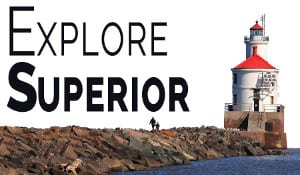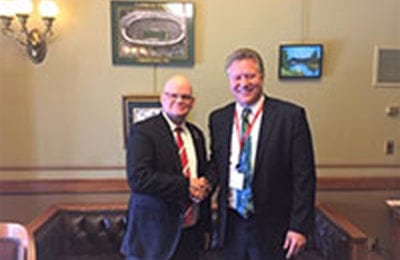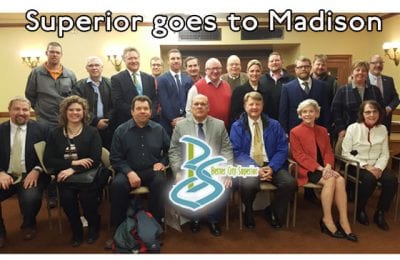BCS Is Getting Closer to Becoming a Reality
Explore Superior has been covering the ongoing efforts of local leaders to bring a large development to our downtown area. The Better City Superior group of concerned business and government leaders first gained the consent of local residents by a 3 to 1 margin to move forward in pursuit of permission to form an Exposition District in Superior.
Now the drive is to get the seal of approval from State government in order to impose a ½% sales tax on prepared food and beverage sales, along with a 2¾% sales tax on hotel/motel stays. During the recent “Superior Days” at the state Capitol, local promoters were successful in getting Sen. Tom Tiffany, a Republican legislator, to come out four-square behind Better City Superior.
Superior is getting closer to successfully gaining the right to improve its downtown through development thanks to leaders like Senator Tiffany.
Making a Case for Downtown
Proponents of BCS believe that our downtown is poised for development, having just undergone a massive street improvement project from the North End to Belknap Street. Additionally, there are numerous vacant lots, and empty buildings in that district that are prime candidates for inclusion in a development of this nature.
The opportunities that exist in our downtown have been explored in a detailed fashion, and much of that information has been shared by this news outlet over the past year+. At the bottom of this article is a directory of the many articles ES has published about BCS, detailing the opportunities that exist in our downtown.
What About the Water Front?
There are some who, while in favor of development, question why downtown. Why not go to the shoreline like has been done in Duluth? Rather than try to re-enliven a dying downtown, they would rather develop our shorelines in hopes of attracting the same type of tourism that is seen in Duluth.
The fly in the ointment is a document known as the Wisconsin Constitution. According to the Wisconsin Department of Natural Resources, our lakes and rivers are public resources, owned in common by all Wisconsin citizens under the state’s Public Trust Doctrine.
Further defined by lawsuits and statues, the Public Trust Doctrine declares all navigable water to be “common highways and forever free” that are held in trust by the DNR.
The logic behind this doctrine is that it is the government’s obligation to assure public rights to waters. These rights include not only rights of transportation on navigable waters, but also protection of water quality and quantity, recreational activities, and scenic beauty. The Public Trust Doctrine holds that certain natural resources like navigable waters are preserved in perpetuity for public use and enjoyment.
Riparian Rights vs. Public Trust
Wisconsin law recognizes that owners of lands bordering lakes and rivers – “riparian” owners – hold rights in the water next to their property. These riparian rights include the use of the shoreline, reasonable use of the water, and a right to access the water. However, the Wisconsin State Supreme Court has ruled that when conflicts occur between the rights of riparian owners and public rights, the public’s rights are primary and the riparian owner’s secondary.
In a nutshell, this is the crux of the problem when it comes to consideration of redeveloping any waterfront area in Wisconsin. Some would say it’s not a problem, but a protection. By constitution, the State of Wisconsin limits the development of state lake shores that have been created as filled land to only public access or industrial uses. No private commercial use is allowed. To make matters more convoluted, what constitutes “filled land” is sometimes defined by maps that date back to the 1890’s.
Presently, the shorelines of Superior abutting the bay are almost entirely zoned industrial, and are thus unable to be used for any other form of commercial use. The following table address acceptable uses of water front properties in Superior. It was taken from the Duluth-Superior Port Land Use Plan, as published by Metropolitan Interstate Council in December of 2016.
City of Superior Zoning Codes
According to a study by the Metropolitan Interstate Committee, it appears that only three zoning districts are present ly allowed along the Superior waterfront (other than some very small slivers of other districts): Waterfront-1 (W-1), Manufacturing-1 (M-1), and Manufacturing-2 (M-2).
The W-1 dominates the Superior waterfront (shown in blue in the map below.) Permitted uses include water dependent land uses and also any use permitted in the M-2 heavy manufacturing district with planning commission approval.
The Light Manufacturing District (M-1) is limited to a couple of small areas along the Superior waterfront. The permitted uses include those less capital intensive than heavy manufacturing and that have a normally lower environmental impact than heavy manufacturing.
This table demonstrates what Superior can and cannot do along its waterfront under current law.
Development Type |
Acceptable Under Public Trust |
Comments |
| Restaurant Building | No | Limited food service may be allowable where it supports, and clearly is an appurtenance to, a permissible use |
| Restaurant Ship or Barge | Not unless it operates as a licensed watercraft.
|
Same as above
|
| Municipal Civic Center | Yes | Must comply with Supreme Court guidelines |
| Hotel/Motel | No | |
| Residences (apartment, condominium, house)
|
No | |
| Harbor Facilities | Yes | Can be private or municipal
|
| Private/public shore protection | Yes | Not trust related but a generally permissible exercise of riparian rights |
| Fish or wildlife habitat management or enhancement projects | Yes | Must comply with Supreme Court Guidelines |
| Public park, including “festival parks”, or recreation area | Yes | Must comply with Supreme Court Guidelines |
| Park administration building | Possibly if for administration of water front park(s) | Must comply with Supreme Court Guidelines |
| Marina (and related facilities necessary for operation of marina) | Yes | Must comply with Supreme Court Guidelines |
| Amphitheater for plays and other cultural events | Yes | Must comply with Supreme Court Guidelines |
| Confined dredged material disposal facility (CDF) | Yes | Ultimate use must be compatible with trust doctrine and Supreme Court guidelines. |
| Filling to extend private riparian property into water | No | |
| Parking lot | Possibly if ancillary to an allowable use | Must meet Supreme Court guidelines |
| Industrial facility | No (except facilities related to ship building or repair which are water dependent) | Must meet Supreme Court guidelines |
While there have been some actions taken by members of the state assembly to modify the above restrictions, the possible success of these moves is unknown at this time. Even if the guidelines for use of our water front in Superior is changed to permit development of the nature seen in Duluth, it will be a long process.
On the short-term, Superior is much better served by pushing to redevelop and improve our downtown area. This is a doable plan that will make Superior a better place to live. It also will become a reality much sooner than waiting for waterfront development that may never become legal and viable under state law.
Citizens interested in supporting a change to these riparian limitations by virtue of the Public Trust Doctrine are encouraged to express their views to our state representatives and Senator Tom Tiffany (R-Hazelhurst), District 12, at (608) 266-2509 | Sen.Tiffany@legis.wi.gov).
Here is contact info for our local representatives:
Nick Milroy (D-South Range), District 73, (608) 266-0640 | (888) 534-0073 | Rep.Milroy@legis.wisconsin.gov
Janet Bewley (D-Ashland), District 25, (608) 266-3510 | (800) 469-6562 | Sen.Bewley@legis.wi.gov
If it can ever change it will be by the will of the people. For more information about Better City Superior, scroll down to the bottom of this screen for a directory of articles published by Explore Superior over the past year or so.
Here is historical background on riparian rights from the Wisconsin DNR…
Other articles from Explore Superior about Better City
Better City Superior Footprint Variable (March 11, 2017)
The Future of Superior (March 2, 2017)
How Land Will Be Acquired for Better City Superior (February 18, 2017)
Superior is Ready for Growth (February 10, 2017)
Indoor Water Park Downtown Planned (February 3, 2017)
Can Superior Lead Itself to be a Better City? (February 1, 2017)
Where Do You Stand On Better City Superior? (January 18, 2017)
iFLY, You Fly, Could We All Fly? (December 20, 2016)
Five Mayoral Candidates Support BCS (December 16, 2016)
Tourism Data Encourages Better City Superior (December 16, 2016)
Better City Says Thank You to Superior (November 11, 2016)
Better City Superior Referendum Passes (November 8, 2016)
Why Superior Real Estate Taxes Are High (November 7, 2016)
A Plea for Faith and Change (November 7, 2016)
ES Interviews Bruce Thompson about BCS (November 4, 2016)
A Tale of Two Tickets (November 3, 2016)
Bar & Restaurant Owners Favor Better City (October 28, 2016)
Labor & Business United for Better City (October 28, 2016)
Better City Superior Public Meeting (October 28, 2016)
Better City Releases Video (October 14, 2016)
What Price Progress? (October 12, 2016)
Better City Superior Issues Status Report (October 1, 2016)
Lunch & Learn About BCS (September 23, 2016)
Better City Survey Results (September 13, 2016)
Origin of Better City (September 9, 2016)
Better City Vision Shared (August 31, 2016)
Better City Receives Council Support (August 18, 2016)
Better City Wants Your Opinion (December 16, 2015)
Better City Initiative (November 5, 2015)






You say that the waterfront is not able to be developed but yet it happens all the time if you’re the right people in Superior. One quick look at Barkers Island is a good example. The far side of the island was zoned for a bird sanctuary, but that changed so fast when the right people wanted to build there. Now they have built homes on the harbor side that are so close to the harbor that two steps out the front door will have you in the harbor. So until you can explain that to me, I’ll never believe anything in this article.